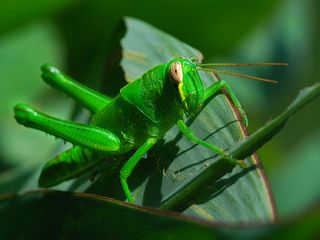
What Makes Grasshoppers Swarm?

Similar to the foreboding locusts warned about in the Bible, grasshoppers can also swarm, wiping out entire crops in agricultural areas and devastating farming economies.
Grasshoppers and locusts are closely related, but while all locusts can fly, some species of grasshoppers do not have wings and are therefore earthbound. There are more than 10,000 known species of grasshoppers, according to the the Department of Agriculture (USDA).
Most species of grasshoppers have wings and can fly pretty well, using their large hind jumping legs as a booster to propel them into the air, where they spread their wings and take off, according to the USDA. Other grasshopper species simply do not develop wings.
Some grasshoppers can be major crop pests, such as the two-striped grasshopper, which is prevalent in North America and can completely destroy crops during a swarming outbreak, according to the USDA.
Both locusts and grasshoppers can enter what scientists call "a gregarious state." An increase in the chemical serotonin (which boosts moods in humans) may trigger this swarming state, according to a study in the journal Science.
Weather conditions impact swarming patterns, according to the USDA. For instance, two-striped grasshoppers swarm to migrate in search of food strictly between the hours of 10 a.m. and 6 p.m., if there are clear skies and temperature has risen to at least 75 degrees Fahrenheit (24 degrees Celsius).
Not only punctual, a swarm of locusts or grasshoppers is also very structured. A single grasshopper flying along follows its own random path, but when approached by a dense group of flying grasshoppers, it joins their formation and flies in an organized way as a member of the swarm.
Sign up for the Live Science daily newsletter now
Get the world’s most fascinating discoveries delivered straight to your inbox.
In this way, swarming brings order to the grasshoppers' individual chaotic flying patterns, also providing them with strength in numbers as they gather around dwindling patches of vegetation during dry seasons or simultaneously fly off to escape predators.
This natural system of "collective motion," which spells doom for a crop, is also common among ants, birds and fish.
Most Popular

